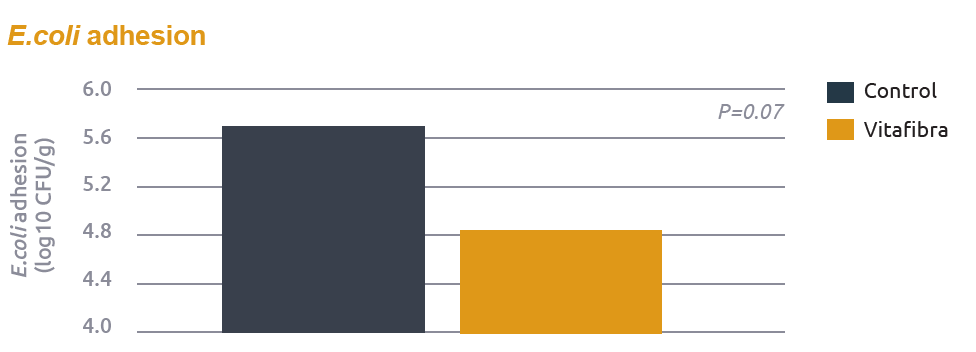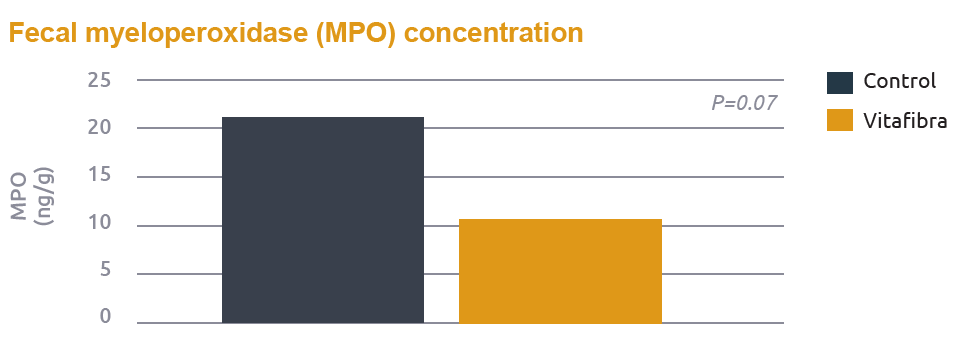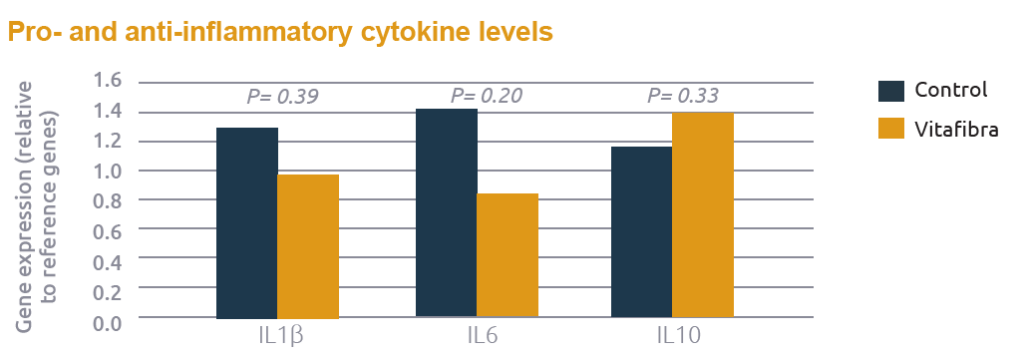By Sofie Tanghe and Maartje De Vos (R&D Functional feed ingredients at Agrifirm)
Piglets face a lot of challenges around weaning, which often leads to impaired gut health. An important cause of post-weaning diarrhea is infection with enterotoxigenic E. coli F4 or F18. Recently, Agrimprove published a peer-reviewed article in Frontiers in Veterinary Science which demonstrates how the use of a health fiber, called Vitafibra, can help combat piglet post-weaning diarrhea due to E. coli F4 or F18 infection.
Enterotoxigenic E. coli, the cause of misery
Post-weaning diarrhea in piglets is often caused by enterotoxigenic E. coli (ETEC) F4 or F18. In fact, according to Nguyen et al. (2017), there is a 98% chance to find a pig that is genetically susceptible to E. coli F4 or F18 in the pig population in Flanders, Belgium. This high susceptibility prevalence undeniably results in severe economic losses due to mortality, reduced growth rate, and cost of medication.
The initial step of an E. coli infection is the attachment of E. coli to enterocyte receptors present in the small intestine. This attachment allows E. coli to overcome the flushing action of small intestinal peristalsis and to colonize the intestine. Once E. coli adheres to and colonizes the small intestine, it starts to produce enterotoxins–toxins excreted by gram-positive and gram-negative bacteria that affect the gastrointestinal tract, hence ‘entero’–to trigger acute and severe diarrhea (Kim et al., 2022; Figure 1).
The pathogenesis of enterotoxigenic E. coli (ETEC)

Furthermore, during the active cellular growth and cell lysis of E. coli, pyrogenic endotoxins located on the outer membrane are released. These endotoxins, or lipopolysaccharides (LPS), bind to toll-like receptor 4 (TLR4) present in the intestine. This activates the NF-κB signaling pathway and leads to the production of pro-inflammatory cytokines that initiate inflammation (Lin et al., 2020).
Discovering a solution
To combat piglet post-weaning diarrhea, the R&D team of the Royal Agrifirm Group has developed a health fiber, called Vitafibra, with a dual mode of action: the functional fibers of Vitafibra are selected to bind with E. coli—preventing its adhesion—and are also able to lower intestinal inflammation. Recently, a peer-reviewed article was published in Frontiers in Veterinary Science demonstrating the mode of action of Vitafibra (Tanghe et al., 2023). In this study, the piglets were weaned at 23 days of age and were then fed a diet with or without 2 kg/mT of Vitafibra for the first 14 days post-weaning. At day 14, as an indicator of the attachment of E. coli to the intestinal wall, small intestine tissues were sampled to quantify E. coli colonization on the mucosal epithelium. Histo-morphological indices and gene expression of pro- and anti-inflammatory cytokines as well as NF-κB were analyzed. Furthermore, samples of the intestinal content were taken from the ileum, caecum, and colon, to analyze specific intestinal bacteria and SCFA (short-chain fatty acids). Finally, fecal samples were taken to measure myeloperoxidase (MPO)—a specific marker of neutrophil activity—as an indicator of intestinal inflammation.
Lowering E. coli adhesion is key
Adding Vitafibra to the piglet diet decreased E. coli colonization to the mucosal epithelium from 5.7 to 4.8 log10 CFU/g, indicating a lower binding of E. coli to the receptors of the gut wall (Figure 2). As it will lead to a lower multiplication of E. coli, the inhibition of bacterial adherence to the receptors is an important step to preventing the initiation of the infection process. This decrease in E. coli presence was confirmed in the study, as a reduction in the E. coli concentration was observed in the ileum, caecum, and colon content. Furthermore, the piglets fed the diet with Vitafibra had better fecal consistency scores during the first 14 days post-weaning. It is probable that the lower adhesion and colonization of E. coli reduced the production of enterotoxins, which resulted in less diarrhea.

Also the MPO concentration in the piglet feces decreased by 49%, indicating lower intestinal inflammation in the Vitafibra group (Figure 3). When E. coli adheres to the epithelial cells and colonizes the intestine, higher numbers of neutrophils are attracted into the intestinal lumen. Therefore, a lower MPO concentration indicates a lower E. coli adhesion and less intestinal inflammation.

Finally, the effect on gene expression revealed some interesting insights into how Vitafibra can impact immunity. Vitafibra decreased the gene expression of both NF-κB subunits NF-κB1 and RELA by 19% and 25% respectively, which may indicate a lower stimulation of the NF-κB signaling pathway. This lower stimulation will generally result in lower intestinal inflammation (Figure 4), which was confirmed by the decrease in the expression of the pro-inflammatory cytokines IL1β (-26%) and IL6 (-42%), and the increase in the expression of the anti-inflammatory cytokine IL10 (+25%).

A healthy gut leads to a healthy animal
Next to the decrease in E. coli concentrations, other beneficial effects in the gut were observed. There was an increase in Lachnospiraceae, which are butyrate-producing bacteria. As butyrate concentration increased for the piglets fed Vitafibra, this increase correlated well with the differences observed in the SCFA concentrations. Additionally, butyric acid is a preferred energy source for the enterocytes and helps regulate cellular differentiation and proliferation within the intestinal epithelium. Thus, butyric acid helps to maintain a healthy epithelium and efficient nutrient uptake (Koh et al., 2016). Next, the villus/crypt ratio and the villus surface area in the piglets’ small intestines were higher for the piglets fed Vitafibra, which may indicate better nutrient absorption. Finally, the number of goblet cells increased in the Vitafibra group, which may indicate better immunity and barrier function at the mucosal surface.
The beneficial effects on gut health observed in the study translated to better piglet performance and health. The findings of the study demonstrate that adding Vitafibra to the piglet diet can help to improve the feed conversion ratio by 17% and result in better fecal consistency. Overall, it is clear that Vitafibra can protect piglets during the challenges of weaning. By preventing the adhesion of E. coli to the gut wall, fewer bacteria can colonize the intestine, which leads to a healthier gut and better-performing animals.